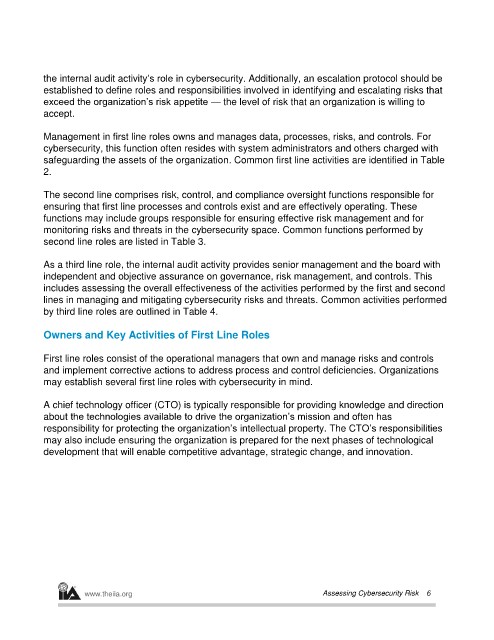Page 341 - ITGC_Audit Guides
P. 341
the internal audit activity’s role in cybersecurity. Additionally, an escalation protocol should be
established to define roles and responsibilities involved in identifying and escalating risks that
exceed the organization’s risk appetite — the level of risk that an organization is willing to
accept.
Management in first line roles owns and manages data, processes, risks, and controls. For
cybersecurity, this function often resides with system administrators and others charged with
safeguarding the assets of the organization. Common first line activities are identified in Table
2.
The second line comprises risk, control, and compliance oversight functions responsible for
ensuring that first line processes and controls exist and are effectively operating. These
functions may include groups responsible for ensuring effective risk management and for
monitoring risks and threats in the cybersecurity space. Common functions performed by
second line roles are listed in Table 3.
As a third line role, the internal audit activity provides senior management and the board with
independent and objective assurance on governance, risk management, and controls. This
includes assessing the overall effectiveness of the activities performed by the first and second
lines in managing and mitigating cybersecurity risks and threats. Common activities performed
by third line roles are outlined in Table 4.
Owners and Key Activities of First Line Roles
First line roles consist of the operational managers that own and manage risks and controls
and implement corrective actions to address process and control deficiencies. Organizations
may establish several first line roles with cybersecurity in mind.
A chief technology officer (CTO) is typically responsible for providing knowledge and direction
about the technologies available to drive the organization’s mission and often has
responsibility for protecting the organization’s intellectual property. The CTO’s responsibilities
may also include ensuring the organization is prepared for the next phases of technological
development that will enable competitive advantage, strategic change, and innovation.
www.theiia.org Assessing Cybersecurity Risk 6

